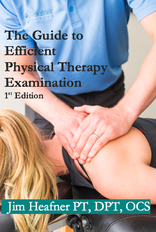 Physical Therapy school prepares therapists to be general practitioners. Upon graduation, PTs are not experts in Orthopaedics, Cardiopulmonary, Geriatrics, or any specific subject area. There is simply not enough time! Due to a lack of classroom time, education focuses on the best current evidence, much of which is guided by pathoanatomy. To become an expert, we need to apply ourselves on a much further level. Below I have listed 2 clinical concepts that are not given adequate attention in Orthopedic Physical Therapy practice. Muscles can be dominant, but still weakMost people are trained to view muscles as either short and strong OR long and weak. Clinically, this is not always how muscles function. The upper trapezius is a classic example of muscle dominance with poor performance. The upper trap functions to upwardly rotate and elevate the scapula. The function of this muscle is especially important above 90 degrees of shoulder flexion. Due to scapular positioning, prolonged postures, and body composition, many people overactive the upper trapezius in lower levels of shoulder flexion (0-90 degrees). Consequently, the muscle becomes 'dominant' early in the range of motion. In these individuals the upper trapezius is actually weak in the functional range (above 90 degrees). When this muscle prematurely activates, it can lead to shoulder impingement syndrome or rotator cuff dysfunction. For this reason, it is important to retrain the upper trapezius in the functional range of motion. The upper trapezius is a single example of muscle dominance. Similar dysfunction can also be found in the hip flexors and hamstrings. Treat the joint first and the 'tight muscle' will resolve itselfThe joints are the gate-keepers to our other tissues. We cannot clear up muscle dysfunction or movement impairments if the joint is not moving properly. An example of this clinical reasoning is treating the thoracic spine with shoulder dysfunction. If a patient lacks upper thoracic extension or side bending, they will not be able to fully reach overhead. The hypomobility in the thoracic spine will limit rib cage expansion as well. If the practitioner only focuses on glenohumeral joint mechanics and scapular strength, they are not treating a major cause of the dysfunction. While the patient may make improvements, the long term solution to this problem is addressing the spine in conjunction with retraining the shoulder complex.  -Jim Heafner PT, DPT, OCS OPTIM COMT Instructor Jim is author of The Guide to Efficient Physical Therapy Examination & the Anatomy of Human Movement (an online movement resource). Purchase these products together & save nearly $40 (offer expirations 1/22/17)
7 Comments
Belen Sancho
1/16/2017 09:27:50 pm
I would like to know what exercises do you use with the patient to resolve the problem.
Reply
Jon D
1/17/2017 08:14:09 am
A great example of dominant but weak/inefficient is after surgery. TKA for example, many have quad dominant pattern with weak/inefficient function, though this is also typically short and weak (at the time). Great concepts!
Reply
2/21/2023 11:50:17 am
This blog is a refreshing take on the two important clinical concepts that are often overlooked in physical therapy school. The author's perspective highlights the importance of understanding and implementing patient-centered care and considering the influence of psychosocial factors on patient outcomes. These concepts are often overlooked in physical therapy education, and the author's insight sheds light on their significance for the clinical practice. The blog is well-written, and the concepts are presented in an accessible and concise manner, making it an informative read for both students and practicing physical therapists. Overall, this blog serves as a valuable reminder of the essential concepts that can improve patient outcomes and should be integrated into the training and practice of physical therapy.
Reply
2/27/2023 09:45:43 pm
This article provides details about 2 important clinical concepts overlooked in physical therapy school. This blog happens to be one of the best blog, which give proper details about it. I enjoyed reading this blog and would suggest others too, and you would get to read about it in this link.
Reply
3/3/2023 05:16:52 pm
It helped when you said that providing appropriate training for your joints and muscles could help improve their function. The other night, my best friend informed me he and his missis hoped to have a consultation with a physical therapy service to help him with his unhealed ankle injury. He asked if I had opinions on the best option for treatment. I like this instructive article, I'll tell him it will be much better if they consult a trusted physical therapy service as they can help him figure out the best treatment.
Reply
2/21/2024 07:14:12 am
You made a good point when you discussed that the gatekeepers to our other tissues are the joints. My friend wants to opt for physical therapy. I should advise him to go for it to enhance his mobility.
Reply
Leave a Reply. |
Details
ContactEmail Good readsCategories |


 RSS Feed
RSS Feed